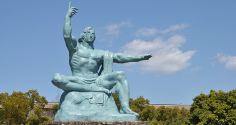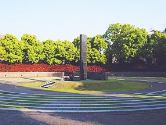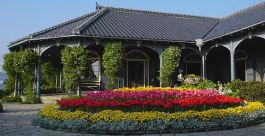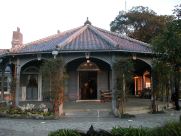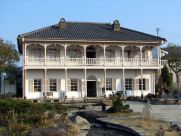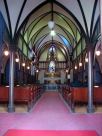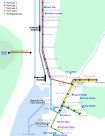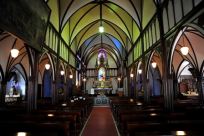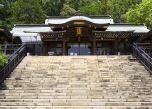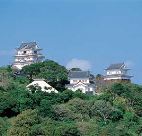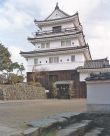History of Nagasaki 長崎の歴史
Nagasaki is the capital city of Kyushu, in famous for the atomic bombing in 1945, on August 9, 1945 is Japan's first gateway to the West. The first visitors to Nagasaki were St Francis Xavier and his followers in 1560. Omura Sumitada, a regional lord was among the first Japanese to convert to Christianity. Under Omura, Nagasaki became a major port for Portugese trade ships to arrive. During the years 1637-1638, due to the Shimabara peasant uprise, Japan had banned contacts with the foreigners and traveling outside of Japan was forbidden. When Nagasaki opened itself again in 1850, it quickly estalished itself as a economic force especially in shipbuilding industry, which led it to become a target on August 9, 1945.
Nagasaki Peace Park 平和公園
Nagasaki Peace park was establish in memorial of the Atomic bombing in Nagasaki. It is located on a low hill north of the hypocenter of the atomic blast. A 9.7 meter high peace statue can be seen in the park, which symbolizes Nagasaki's citizens wish for peace. Each year, on August 9th a Peace Memorial Ceremony is held of the statue while the mayor of Nagasaki delivers a Peace Declaration to the World.
Access information: Tram line 1 or 3 from Nagasaki station in 10 minutes, the park is a short walk from Matsuyamamachi or Hamaguchimachi tram stop.
Address:Matsuyama-machi, Nagasaki
Fees: Free
Atomic bomb museum: 8:30-6:30 (until 17:30 from September to April)
Fees: 200 yen
Parking fees: 250 yen/hr
More information: http://www.japan-guide.com/e/e4400.html
Glover Garden グラバー園
Glover Garden is a garden built for Thomas Blake Glover. The oldest Western style building in Japan- Glover Residence stands in the park. It was completed in 1863, the well known" Madame Butterfly House" and " Statue of Puccini" stands beside and aorund the house.
Access information:Take line 1 (Shokakuji-shita) from Nagasaki Eki-mae to Tsuki-machi. Transfer to line 5 (Ishi-bashi) and take the tram to either Oura Tenshudo-shita or Ishi-bashi. (approx. 15 minutes) A 8 minute walk to Glover park
Opening hours and fees: 27 April (Sat) ~5 May (Sun) 08:00 - 21:00
19 July (Fri) ~ 9 October (Wed) 08:00 - 21:30
22 December (Sun) - 25 December (Wed) 08:00 - 21:00
All other periods- 08:00 - 18:00
Garden entrance fee- 600 yen
Tel: 095-822-8223
Link to homepage:http://www.glover-garden.jp/foreign/english.html
More information: http://www.japan-guide.com/e/e4406.html
Oura Church 大浦天主堂
Oura Church is only western style building declared as a national treasure and the oldest church in Japan. It is built mainly for the growing community of foreign merchants in 1864. In 1863, two French preists landed in Nagasaki to built a church in honor to the Twenty- Six Martyrs of Japan. It was desinated as a national treasure in 1933.
Access information: Oura Church is a five minute walk from Ouratenshudo-shita tram station on line number 5. It is justt next to the entranc eof Glober Garden.
Opening hours: 8:00-18:00
Admission Fees: 300 yen
Tel: 095-823-2628
Link to homepage:http://www1.bbiq.jp/oourahp/
More information: http://www.japan-guide.com/e/e4407.html
Nagasaki's culture, Lantern Festival
Being one of Japan's first cities to recieve early contact with the foreigners, many traditional festivals and food culture came about under the foreigner's influence. The Nagasaki Lantern Festival is held from January 1st to January 15th of the Chinese Lunar Calender. Originally, the festival was celebrated by the Chinese residentsin Nagasaki, and since 1994, it has officially become one of Nagasaki's traditional festival. On this day, families would decorate their own lantern at Chinatown.
Festival location: Shinchi Chinatown, Chuo Koen, Tojin Yashiki, Kofukuji, Kaji-ichi, Haman-machi Arcade, Koushi-byou (Confucian Shrine)
For more information , please visit:
http://www.at-nagasaki.jp/foreign/english/ranfes/
http://www.at-nagasaki.jp/foreign/english/pdf/2013Lantern_English.pdf
Link to homepage: http://www.nagasaki-lantern.com/
Chanpon
Chanpon was invented by a Chinese restaurant owner named Shikairo who wanted to serve the visiting Chinese students a cheap and nutritious dish. The original version was a simple combination of pork and bamboo shoots, but eventually more locally abundant ingredients and seafood such as squid, oysters, and shrimp were added in. The origin of the word "chanpon" is the Fujian word shapon, which means "to eat a meal."
Chanpon is served in Sikairo, Chinese restaurant in which Chanpon was invented. The restaurant was established in 1899.
Address: 〒850-0921 長崎県長崎市松が枝町4-5
Tel: 095-822-1296
Opening hours: 9:30am~6:30pm
Link to homepage: http://www.shikairou.com/index.htm
Suwa Shrine 諏訪神社
A major shrine in Nagasaki and the home of Nagasaki Kunchi . There are 277 steps that leads up to the mountain in which the Shrine stands. This shrine is dedicated to Suwa-no-Kami, the god of valor and duty.
Tel: 095-824-0045
Fees: Entrance and parking free
Further reading:http://journalism.berkeley.edu/projects/nagasaki/stories/suwashrine.html
Hirado Castle 平户城
Hirado Castle, also known as Kameoko Castle is located at present day Hirado city, Nagasaki. It was built durign the Edo period and was completed in 1718. The castle stands on a small rounded mountain facing Hirado Bay , its three sides surrounded by water.
Address:Hirado city, Iwanoue-cho 1473, 〒859-5121
Tel: 0950-22-2201
Opening hours: 8:30~17:30
Admission fee: Adult 500 yen Adolescents(age 15-19) 300 yen
Children-200 yen
